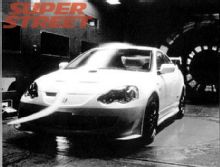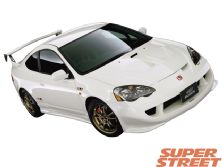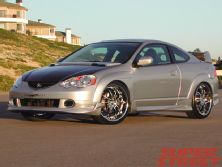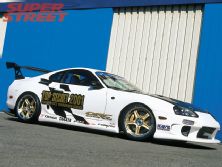OK, I'll admit it: The title to this story is an outright lie. For some of the articles I've written previously, the "All About..." heading seemed like a good way to encapsulate the basic, technical-overview approach to whatever subject our esteemed editor tossed my way. Aerodynamics is a whole different deal. Reams of paper, stacks of books, even entire university degree programs have been created to explain this slippery subject, so there's no way I'm gonna be able to cover it all in just a few magazine pages. I'm keeping the title, though. While "Can of Worms" would be a more accurate description of what I went through researching this story, it just doesn't quite have the same ring to it.
What do I mean by can of worms? A couple of things. For a scientific principle that's based on lots of complicated terms and mathematical equations, aerodynamics is tough to pin down. There are so freaking many variables to take into account when figuring the proper aerodynamic envelope for a vehicle that five different engineers can come up with five different answers to the same problem, even if they all use the same calculator. I'm not exaggerating here. Aerodynamic forces, and the means of harnessing them, can literally change with the weather. (Warm air isn't as dense as cold air, and humid air isn't as dense as dry air, and passed gas is just downright smelly.)
And then there's the whole form versus function issue. Let's face it: Most of the aerodynamic pieces we hang on our cars-wings, spoilers, air dams and such-are there because they look good, right? We see 'em on race cars and we want 'em on our cars. But do you really know how they affect your car's aerodynamic performance? Probably not. Guess what! The kit's manufacturer may not know either. Not exactly, anyway.
You see, about the only way to truly judge aero performance is either in a wind tunnel or through countless hours of data-logging in real-world environments. Yet few kit makers have the resources-wind tunnels can cost $1,000 an hour, or more, to use-to subject their designs to that sort of testing. So companies that can't tunnel-test use all sorts of methods to design their pieces, from fluid dynamics equations to replicating race-car components to going on sheer eyeball appeal. The makers who take a scientific approach to kit design have at least some idea that their pieces will improve aerodynamic performance. Those whose designs are based purely on style, well, don't.
Given that uncertainty, how can you choose the best aero kit for your car? Damn fine question. Let's start by examining some aerodynamic basics, and then ask some experts for their advice on how to cut cleanly through the air.
Aerodynamic Basics
Anyone who has stuck their hand out of a moving car has experienced the effects of aerodynamics At freeway speeds you can feel how hard the air is buffeting your hand; imagine how strong the forces are on something as big as your car.
Those forces of wind resistance against your hand-or your car-are called drag. Engineers measure a car's ability to slip through the wind by assigning it a drag coefficient (CD), which is calculated through a mathematical equation. For you math whizzes out there, the CD equation is:CD = D/(1/2xpV2xA), where D is drag, p is air density, V is velocity, and A is the car's frontal area.
The sleekest production cars right now (the '02 NSX, Porsche 911, or Corvette, for example) have CD values in the 0.30-0.29 range. A mid-'80s Honda Civic, on the other hand, was in the 0.37 to 0.39 range. An old-school VW Beetle? Halfway to a barn door at 0.49.
Reducing drag and lowering that CD is one of the main goals of aerodynamic improvements, as getting a car to slice cleanly through the wind has several benefits. Probably the most important one is efficiency: Reduce the drag that's acting on a vehicle and you can reduce the power needed to push it through the air. An engine that doesn't have to work as hard gets better fuel economy, which is why aerodynamics are so important to the new car industry.
There's a flip side to the efficiency deal too. If you can clean up a car's aerodynamics so that it needs less horsepower to push it through the air, there will be more power available to push that car faster. That's why all those land-speed-record cars look more like airplane fuselages than cars.
How do you reduce drag? By smoothing the flow of air over, around, and behind the car. OE designers have come up with all sorts of tricks to lower drag, from reducing a car's frontal area to molding in small winglets under the trunk area to diffuse the air that comes out from underneath it.
But drag is just one aerodynamic factor that's at work on your car. Two other forces you've probably heard about before are lift and downforce. Look at the side view of a modern car and the shape looks something like the cross-section of an airplane wing, doesn't it? Well, if it looks like a wing, you'd better believe that at certain speeds, the air flowing over and under the car is going to make it work like an airplane wing and lift it, somewhat. It may not leave the ground (at least, we hope it doesn't), but there could be enough lift to unload the tires and suspension, which will affect the car's traction and handling.
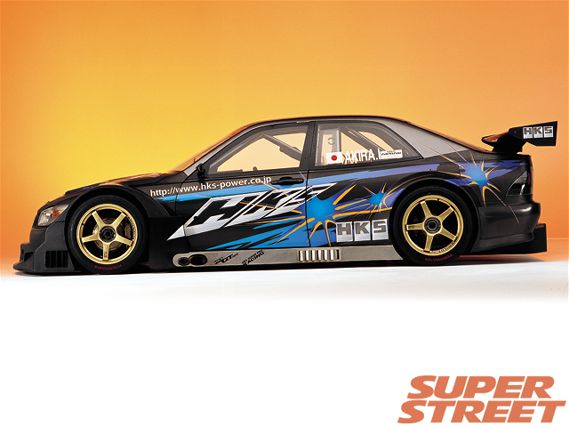 | The HKS Track Attack Altezza creates so much downforce that it literally sucks the car onto the tarmac.
| The HKS Track Attack Altezza creates so much downforce that it literally sucks the car onto the tarmac.
Adding downforce fights the effects of lift, and more. The proper application of downforce, by manipulating the movement of air over the car, will actually increase the friction between the tires and the ground, so you can accelerate, brake and corner harder without the tires spinning, skidding, or sliding.
Wings and spoilers are the most common tools used to increase downforce. An automotive wing basically takes the design of an airplane wing and turns it upside down, changing an airplane's lift into a force that pushes down on the car. A spoiler is even simpler, as the drag of the air flowing over it creates downforce.
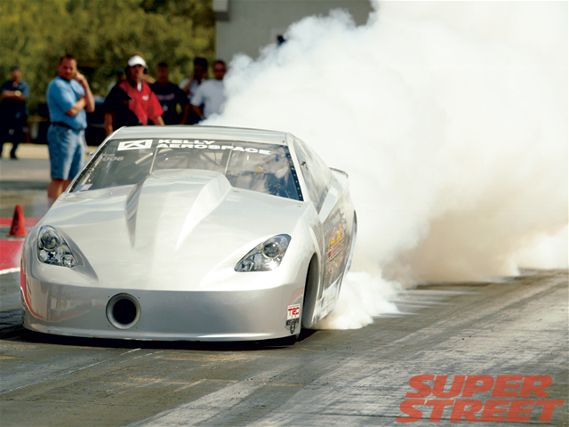 | Kim's aero tips for street cars dealt mostly with controlling the air flowing under the car. Using an air dam or chin spoiler will route air away from turbulence-causing areas in the chassis, like suspension components, oil pans, transmissions and such.
| Kim's aero tips for street cars dealt mostly with controlling the air flowing under the car. Using an air dam or chin spoiler will route air away from turbulence-causing areas in the chassis, like suspension components, oil pans, transmissions and such.
You can also create downforce by lowering a car. Bringing the bottom of the car closer to the ground makes the air flowing beneath it move faster. An aerodynamic principle called Bernoulli's Equation states that faster air speed results in lower air pressure, and low air pressure under the car creates downforce.
When talking about downforce, one word that kept coming up from all the experts was "balance." You have to be careful when exerting downforce on a car so as not to throw off its overall balance. For example, in a front-wheel-drive car, having some downforce on the rear wheels is necessary to stabilize the portion of the car that, for the most part, is just going along for the ride. But exert too much downforce on the rear wheels and you can unload the front wheels, which will result in a loss of traction that hurts acceleration and creates understeer. Conversely, if you put too much downforce over the front tires in an effort to help traction, you could unload the rear wheels and induce oversteer.
Downforce increases as speeds increase, but downforce increases faster than speed. As speed doubles, from, say, 35 to 70 mph, the downforce exerted by a wing or spoiler will increase by four times. This can cause changes in handling and traction characteristics as speeds go up and down. So, again, balance the amount of downforce you're seeking with the type of driving you're doing, so you work up to optimal downforce at peak speeds.
OK, now that you're armed with some aerodynamic basics, let's talk with some experts in the field to find out how to apply these rules. For some more basic aero info, check out our Aero Glossary.
 | Car Aerodynamics - All About Aerodynamics
| Car Aerodynamics - All About Aerodynamics
The 200-mph Celica
In May 2002, the Turbonetics/Scranton Brothers Celica, powered by a twin-turbocharged Tundra V-8, became the first sport compact car to go more than 200 mph in the quarter-mile. And as Tyler Tanaka, Turbonetics' marketing manager put it, when you're looking for high miles per hour, aerodynamics are very important. "You're looking for any way to lighten the load on the engine to make the car quicker and faster."
The body used on the race car contains some Celica body panels, but the envelope was stretched and widened to fit over the drag-race chassis. "We were looking for the lowest CD possible that would still fit on the frame and look like a Celica," Tyler said.
The team doesn't have the resources to test its aero package in the wind tunnel, so they rely on good old fashioned track time to tell them what's working and what isn't. Recently, they realized that the Top Fuel-type wing they were using wasn't creating enough downforce on the rear tires at the speeds they were hitting. "Maybe it might have made a difference at 220 or 230, but not at 205," Tanaka said. So they swapped it out for a Pro Stock-style wing that creates "little drag, lots of downforce, and is adjustable for track conditions. Simpler is sometimes better."
Tyler also said some of the team's aero work is done for reasons other than downforce and drag. Holes in the hood-more properly called NACA ducts-feed air directly into the custom T-Series turbochargers. The design of the flush-mount NACA ducts allows air to drop into the duct without interrupting the flow of air around it, like a hood scoop would.
The Rocket Science of Antony Kim
You may not know his name, but we bet you're familiar with some of the cars Antony Kim has helped to design. An aerospace engineer specializing in race car aerodynamics, Antony brought new levels of airflow control to Steph Papadakis' latest Civic drag car. His work resulted in a car that was not only faster, but also considerably more stable, so much so that Papadakis refuses to drive the old car anymore.
His approach is to create considerable downforce on the front of a a FWD car is to "defy gravity," as he puts it. During a hard launch, much of a car's weight transfers to the rear, which is not good if you want to plant a FWD car's tires for maximum traction. So Antony is upping the downforce on the car's nose. But he has to achieve a balance and keep some downforce on the rear, he says, or the car won't be stable and could come around whenever the driver lets off the throttle.
When we asked Antony if any of his drag-race aero lessons could be used on street cars, his reply surprised us. "Not at all. The forces acting on a drag race car are completely different than a street car. Plus, I'm working on a car with a 75/25 weight distribution, which will never happen on a street car. If you're going to mimic anything, follow a road race car," since it has to do more than just go fast in a straight line.
Antony's tips for improving street car aerodynamics have more to do with air flowing under the car than over it. "Number one: Lower the car. The lower you can make it, the more downforce it creates. Two: Mount an air dam or chin spoiler. This will prevent air from going under the car and getting turbulent when it hits all those protrusions underneath the car. Three: Run the lowest side skirts you can, to seal the sides. This will make the car more stable.
"And remember," he continued, "every little thing you change on the car has an effect on the rest of the car. What you change in front is going to affect the back."
Wind Tunnel-Tested
We found only one company-Mugen-that performs wind tunnel tests on fullsize models of its aerodynamic parts. APR Performance does some testing, but only on quarter-scale models. Mugen starts with the quarter-scale pieces during development work, but eventually tests the parts in 1:1 scale at the Japan Automobile Research Institute in Tsukuba, Japan.
What's so special about wind tunnel testing? It allows a manufacturer to evaluate its aero designs under very controlled and repeatable conditions, resulting in body kit parts that are proven effective at reducing drag and improving downforce. For example, the kit Mugen developed for the RSX, when combined with a lowered suspension and smaller mirrors, increased the car's overall downforce by 168 percent (at 60 mph), and decreased its CD by 11 percent.
The wind tunnel can reveal problems, too, admitted Scott Zellner, president and CEO of King Motorsports, the exclusive U.S. distributor for Mugen. For example, Mugen spent some $20,000 in research and development to design a rear diffuser for an S2000. But during repeated tests they found "they just couldn't make it work," Scott said. So Mugen scrapped the project.
Mugen's testing regimen doesn't come cheap, and it does have an effect on the parts' retail prices. A quick comparison of RSX kits on the Web showed Mugen's full kit, including the front bumper and undercover, side steps, rear wing, and Aero hood, retails for $4,780. A full aero kit from Wings West, including front and rear dams, fender flares, and rear wing, sells for $1,466. For '96-'00 Honda Civic hatchbacks, the story is pretty much the same. Mugen's full Aero kit, with an Aero bumper, wing, side spoilers, and rear bumpers, sells for $3,600. A Kaminari full fascia kit and wing for the same car costs $1,334, and the Wings West version goes for anywhere from $1,100 to $1,200, depending on your choice of wing. Do you get what you pay for? That depends on how serious you are about form versus function.
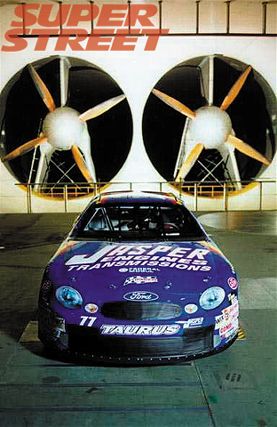 | Car Aerodynamics - All About Aerodynamics
| Car Aerodynamics - All About Aerodynamics
A peek inside the Langley Full Scale Tunnel at the Langley Air Force Base in Virginia will give you an idea of just how big a wind tunnel needs to be to test fullsize vehicles. That's an actual NASCAR Taurus parked in front of the two 35-foot-tall fans, which are driven by 4,000 hp electric motors. The tunnel's test section, where the cars, airplanes, and other objects are placed during testing, is 30 feet high and 60 feet wide. While the Langley tunnel used to be closed to all but NASA projects, it's now open for business and operated by Old Dominion University.
 | Car Aerodynamics - All About Aerodynamics
| Car Aerodynamics - All About Aerodynamics
The Wing's the Thing
APR Performance's K.C. Chow was candid about his company's-and others'-wings. "We don't recommend some wings for the street. They're going to slow the car down, take horsepower away because they generate too much downforce." And an honest-to-god Funny Car wing, for example, is designed to generate in excess of 5,000 pounds of downforce at 300 mph. Without that kind of downforce, the car would have no traction at all, explained K.C., since the 5,000hp engine could easily blow off even those big drag race slicks. But this radical a wing, and most pro drag race wings, don't make any sense for anything but pro racing. Even street-oriented wings don't really start working until you get over 60, K.C. continued. "Below 50 they're for looks only."
One of the reasons we contacted APR was because of the company's dramatic bi-deck wings. We wondered if they really worked. "Absolutely," said K.C.. "The more decks a wing has, the more downforce created."
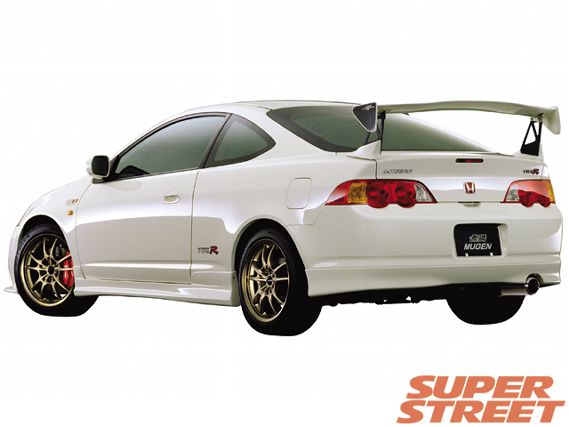 | Car Aerodynamics - All About Aerodynamics
| Car Aerodynamics - All About Aerodynamics
Plus, the bi-wing design offers more adjustability to suit road or track conditions. "You can adjust the attack angle of both decks, to dial in what you need," K.C. said. For conditions where cornering is more important than top speed, increasing the wing's angle of attack (tipping it so it's more perpendicular than parallel to the ground) will increase downforce, but will also increase drag. When top speed is paramount, the angle of attack can be lessened to reduce drag, but with a corresponding reduction in downforce. Wing design and shape are just part of what affects its aerodynamic performance, K.C. told us. Where you mount it, and how high you mount it, also makes a difference. With some wings, if you mount them too close to the car's body, the negative pressure area off the bottom of the wing creates negative pressure on the surface below it, and the two pressure areas cancel each other out. A higher wing pedestal will separate the wing from the trunk and better balance the forces from each.
"It doesn't matter how much horsepower you have," said K.C., "without the right aerodynamics the car won't go anywhere."
Many of the leading Japanese tuners such as and Top Secret and HKS have been using aerodynamic tricks that include innovative diffusers, winglets, and splitters in order to increase downforce for improved stability and adhesion at speed.
Air Dam: A front spoiler used to divert airflow from going under the car.
Bernoulli's Equation: A mathematical equation that states the inverse relationship between air speed and pressure. The equation is:p1/4p + V21/42 = constant, where p is local static pressure, p is air density, and V is velocity.Bernoulli's Equation explains how an airplane wing creates lift: Air traveling faster over the wing than under it creates a low pressure area on top of the wing, which generates lift.
Boundary Layer: The thin layer of air near a vehicle's surface that is most affected by drag.
Downforce: A force created by airflow manipulation that increases the friction between the tires and the road without increasing the vehicle's weight or the size of the tires.
Drag: The friction between the surface of a vehicle and the air flowing around it.
End Plates: Side fins mounted at the tips of wings that can increase their lift.
Flow: Aerodynamicists have several terms to describe the characteristics of airflow. They include:
Attached Flow: Air flowing over a vehicle that follows the shape of the body.
Laminar Flow: Well-organized, linear flow.
Separated Flow: The opposite of attached flow, where air is detached from the body and turbulent.
Turbulent Flow: The extreme opposite of laminar flow.
Lift: The tendency for a vehicle to act like an airplane wing and rise off the road surface.
Spoiler: An aerodynamic device that is integral with the body panels of a car, whether it's trunk-, roof-, or bumper-mounted.
Wing: An aerodynamic device with its own body that is detached from the vehicle so that air can flow above and below it.

